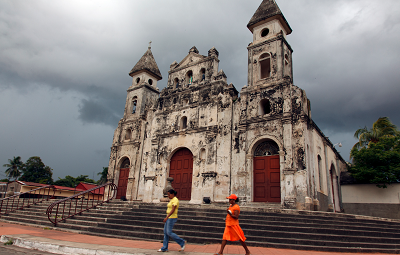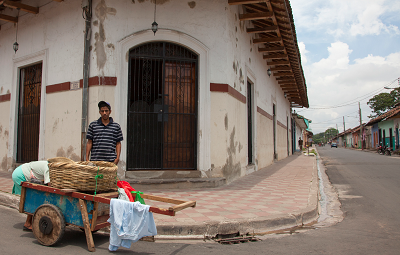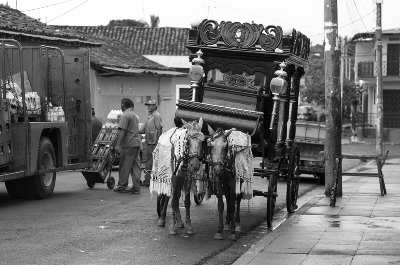Managua 2010
Publish date 11-07-2023
 To talk about Managua I would like to make a local mind, which in my case means letting the place speak through its memory. The memory of a place interacts with ours and the two overlap and form the structure of a story.
To talk about Managua I would like to make a local mind, which in my case means letting the place speak through its memory. The memory of a place interacts with ours and the two overlap and form the structure of a story.
In Nicaragua, almost passing through, I stayed there no more than four or five days: I moved between Managua and the neighboring cities that overlook the great lake Nicaragua, a place where nature reigns supreme. This happened during a tour that in just twenty days allowed me to visit all the countries of Central America. However, they were enough for me to realize how much these countries are united, and how true it is that these states should really be considered as "the back yard of the Yankee neighbors".
In reality, from the very first moments in Managua, I was able to feel the impulses of my feeling of idiosyncrasy which reveals itself and makes its way every time I feel correspondences with my preconceptions.
I am referring above all to what concerns the influences of globalisation. Disappointing evidence that uniforms, throughout the "turnkey" package, made up of symbols which are the usual shopping centres, computer-designed town planning, futuristic architecture and trendy brands, lodges, large hotel chains.
 Aesthetic elements borrowed from industrialized countries, capable of transforming any underdeveloped territory into a sterile, aseptic and uniform place, depriving it in a short time of the cultural elements that have always differentiated and distinguished it. How photographer Lewis Baltz's series of topographical photographs illustrated vast swathes of rural US in the throes of a building boom in the late 1960s. It's sad, I know.
Aesthetic elements borrowed from industrialized countries, capable of transforming any underdeveloped territory into a sterile, aseptic and uniform place, depriving it in a short time of the cultural elements that have always differentiated and distinguished it. How photographer Lewis Baltz's series of topographical photographs illustrated vast swathes of rural US in the throes of a building boom in the late 1960s. It's sad, I know.
This peripheral line transforms any area touched into suburbia: progress has always brought with it a side effect, that degradation destined to remain in the peripheral areas which will become the most ghettoised.
Even in this city, Managua, just take a tour of the more residential neighborhoods to realize how quickly things can change. And it happens as soon as a new mall opens, exactly monstrous and gigantic and like any other you might visit in Los Angeles, Paris or London. If locals want to move to North America in droves, some high-ranking people have seen fit to have the coveted North America move there, right into their homes.
So the demarcation line, the one that on paper should mark the geopolitical border of the United States of America, over the years would seem to have gradually moved further south, lower and lower, advancing hand in hand with the Pan-American road.
 Looking at Nicaragua, one might think that it has been kissed by God and the devil at the same time: the nature and the landscapes, the flora and fauna make Nicaragua an authentic paradise on earth. There are 48 volcanoes in the area, and in 1972 the capital was destroyed by an earthquake that killed thousands. Throughout the 20th century, Nicaragua experienced a century of blood and cruelty thanks to the Sandinista revolution and the regime of the dictator Somoza.
Looking at Nicaragua, one might think that it has been kissed by God and the devil at the same time: the nature and the landscapes, the flora and fauna make Nicaragua an authentic paradise on earth. There are 48 volcanoes in the area, and in 1972 the capital was destroyed by an earthquake that killed thousands. Throughout the 20th century, Nicaragua experienced a century of blood and cruelty thanks to the Sandinista revolution and the regime of the dictator Somoza.
It must be because of the rain of those four days a dozen years ago, but I really don't remember meeting happy people! On the other hand, I found myself observing amazed expressions of a kind of endemic sadness, which I never would have thought I'd find at those latitudes.
The sky is gloomy in Granada, a farmhouse town on Lake Cocibolca. There, while photographing the facade half destroyed by the earthquake of the church of Our Lady of Guadalupe, I notice in the background the skeleton of a yellow-white facade, perhaps another church illuminated by a ray of sunlight.
The scene reminds me of a Tornatore film shot in Bagheria, a Bagheria rebuilt elsewhere, just like this place now organized for tourists that recalls a film set, one of the many Disneyland money-collectors.
While a carriage was advancing with apparently bored tourists, under the hooves of the two pack horses with blinkers, I saw on those gray lava porphyry pebbles, the formation of a patch of blood which, gradually enlarging, made me think back something glimpsed on TV, or in a vintage magazine. Photographs that had disturbed me as a child: they were scenes of violence and bloody struggle that concerned that distant country, which was called Nicaragua and which I never thought I would visit one day.
 I admit it, I struggled a lot to recognize how beautiful what really is, assuming that it is not just a superficial patina that certainly embellishes, but which, like lime, hides what is usually deep inside it continues to ferment.
I admit it, I struggled a lot to recognize how beautiful what really is, assuming that it is not just a superficial patina that certainly embellishes, but which, like lime, hides what is usually deep inside it continues to ferment.
Luca Periotto
NP April 2023







